Shipping lithium batteries is not a joke. Mislabeling them can cause delays, fines, or severe consequences. In this guide, we break down everything you need to know about lithium battery shipping labels, ensuring your shipments are safe, compliant, and hassle-free. No matter where or how they’re shipped.
Understanding lithium battery classifications
There are two main types of lithium batteries:
- Lithium-ion batteries (Li-ion): Rechargeable batteries commonly found in devices like smartphones, laptops, and power tools.
- Lithium-metal batteries: Non-rechargeable batteries are typically used in devices such as watches, cameras, and medical equipment.
Each classification has distinct shipping regulations, so it’s crucial to identify the battery type before shipping.
UN numbers and proper shipping names
Proper lithium battery shipping labels must clearly display the correct UN number to ensure safe handling and compliance. This UN number system standardizes the identification of hazardous materials and their packaging method.
UN numbers for lithium-ion batteries
- UN3480 – For standalone lithium-ion batteries shipped on their own.
- UN3481 – For lithium-ion batteries contained in (installed inside a device) or packed with equipment (shipped in the same package, but not installed).
UN numbers for lithium-metal batteries
- UN3090 – For lithium-metal batteries shipped alone (standalone).
- UN3091 – For lithium-metal batteries contained in or packed with equipment.
Tip: Ship UN3090 lithium-metal batteries only on cargo aircraft. Always label them “Cargo Aircraft Only” to meet international shipping requirements.
Packaging and shipping restrictions
The International Air Transport Association (IATA) defines detailed Packing Instructions (PIs) to ensure both safety and regulatory compliance.
For air shipments, you can check:
- PI965 – Standalone lithium-ion batteries (UN3480)
- PI966 / PI967 – Lithium-ion batteries contained in or packed with equipment (UN3481)
- PI968 – Standalone lithium-metal batteries (UN3090)
- PI969 / PI970 – Lithium-metal batteries contained in or packed with equipment (UN3091)
Each PI includes sections based on battery size and risk:
- Section IA / IB – Fully regulated shipments requiring UN-spec packaging, etc.
- Section II – Previously used for smaller batteries; eliminated for standalone lithium-ion (PI965) and lithium-metal (PI968) shipments as of April 2022.
How to ship lithium batteries?
Before you ship lithium batteries, knowing the key numbers is essential.
For lithium-ion batteries, check the watt-hour (Wh) rating, state of charge (SoC), and package weight.
For lithium-metal batteries, focus on lithium content and gross weight. These values determine which packing instructions, labels, and handling requirements apply.
| Aspect | Air Shipping (IATA) | Sea Shipping (IMDG) |
|---|---|---|
| Speed | Faster, but more restrictive | Slower, but more flexible |
| Quantity limit | Strict per-package limits | Higher allowance |
| Documentation | Requires Shipper’s Declaration | Usually listed on the Dangerous Goods Manifest |
| Packaging | Lightweight, fireproof materials | Heavy-duty containers acceptable |
| Cost | Higher due to safety controls | More economical for bulk cargo |
Lithium battery shipping labels & markings
Lithium battery handling label
It is the most common lithium battery shipping label, especially for air transport under IATA Section IB.
This label is required for:
- Lithium-ion batteries (UN3480 / UN3481)
- Lithium-metal batteries (UN3090 / UN3091)
Label requirements:
- Minimum size: 100 mm × 100 mm (4 × 4 inches)
- Red border (at least 5 mm wide)
- Battery symbol with flame
- UN number (e.g., UN3480 or UN3091)
- Telephone number for emergency contact
Tip: For smaller parcels, you can reduce the label to 100 mm × 70 mm (4 × 2.75 inches) as long as it stays clear and legible.
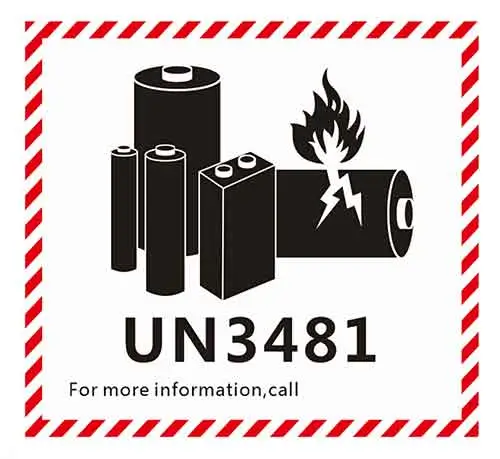
Class 9 dangerous goods label
Fully regulated shipments, like those under Section IA, must display a Class 9 lithium battery label. This label identifies your goods as miscellaneous dangerous materials.
Specifications:
- Diamond shape, 100 mm (4 inches) per side
- Top half: 7 black vertical stripes
- Bottom half: white background with a bold “9”
- No battery image required
This label applies to all Class 9 lithium battery shipments, including high-capacity batteries or bulk cartons.
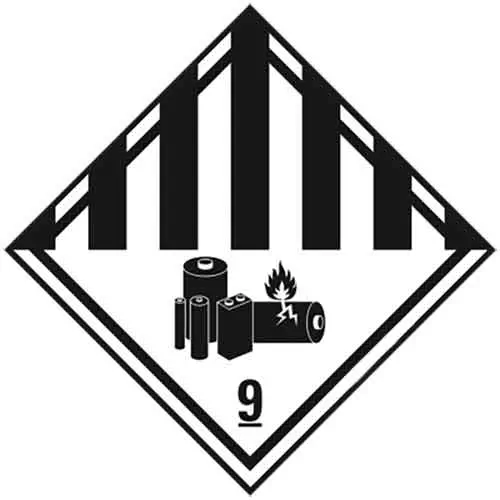
Cargo Aircraft Only (CAO) Label
That bright orange label you’ve seen before? It’s not for decoration.
The Cargo Aircraft Only label tells airline personnel that your package cannot travel on passenger aircraft — ever.
You’ll need this label for:
- Fully regulated Section IA shipments
- Some Section IB shipments
The CAO label’s bold orange color ensures maximum visibility during loading and handling.
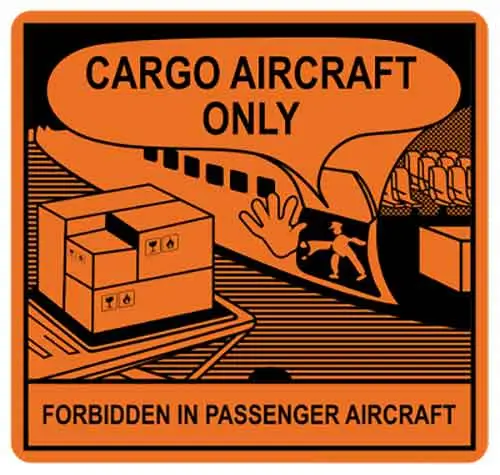
Lithium Batteries Forbidden for Transport Label
This white label with red text clearly warns that lithium batteries cannot deliver by passenger aircraft. You can use it when specific batteries exceed the allowed limits for size, quantity, or configuration.
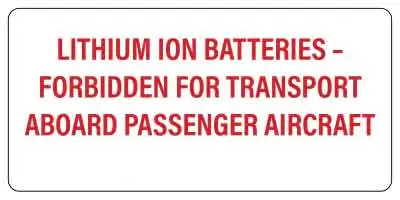
UN3480 & UN3090 label requirements
Based on the packaging and shipping rules outlined above, here’s a summary of the required labels for lithium-ion and lithium-metal battery shipments by section.

UN3481 & UN3091
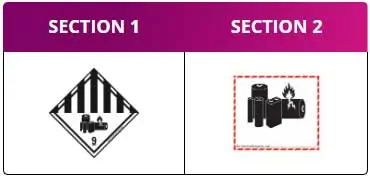
UN3481 > 5kg
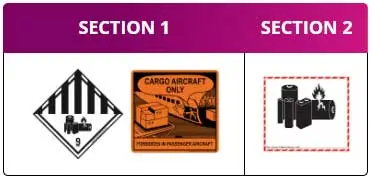
However, label requirements change frequently as safety standards evolve. Before shipping lithium-ion or lithium-metal batteries, always confirm the latest IATA and ICAO regulations. Or let Airsupply logistics experts handle it for you.
How ASLG supports your lithium battery shipments
At Airsupply, we understand that lithium battery shipping requires precision and speed. Here’s how our team makes it simple for you:
- High-volume experience: We manage over 200 lithium battery shipments weekly, from small parcels to 10-ton bulk orders, by air and sea.
- Professional labeling & documentation: Our team ensures every lithium battery shipping label, declaration, and packing document meets IATA and IMDG standards.
- Proactive communication: We stay in touch throughout your shipment, offering quick updates and solutions when challenges arise.




